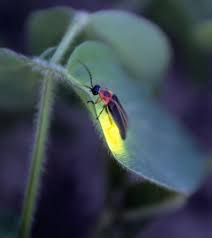Fireflies

Fireflies, also known as lightning bugs, are amongst the unique organisms that use bioluminescence to live and thrive. Fireflies can beautifully light up a summer evening with their subtle glow in many places throughout the world. There are about two thousand species of fireflies but they all belong to the nocturnal winged beetle family, Lampyridae and the order, Coleoptera. Fireflies may be classified under five subfamilies that include Photurinae, Luciolinae, Cyphonocerinae, Lampyrinae, and Otetrinae. Each species of firefly communicate differently, live in varying regions, and emit different colors of light. Most fireflies live in a variety of warm and temperate climates, and humid areas of Asia and the Americas. Adult fireflies typically feed on pollen or nectar.
Although a small number of firefly species do not produce light, the majority of fireflies use bioluminescence to communicate and attract mates by sending optical signals. Fireflies glow in patterns unique to each species. Fireflies and the larvae also use bioluminescence as a defense mechanism, and the light serves as a warning to predators. In most species, the males fly and send light signals, while the females wait in trees or shrubs until she finds an attractive mate to send signals to in return. Fireflies can obtain their glow from organs under their abdomens. Fireflies take in oxygen and combine it with calcium and adenosine trisphosphate (ATP) in the presence of luciferin combined with the enzyme, luciferase, to produce a light, with little heat, in which scientists refer to as “cold light.” Luciferin is heat resistant and luciferase is an enzyme that triggers light emission. ATP energy is needed to convert the energy into light. Fireflies control the beginning and end of their light emission, depending on the amount of oxygen present. Fireflies transport oxygen into their bodies through a small series of tubes called tracheoles. Nitric acid is also produced during the light production process, which binds to mitochondria in the cells and allows oxygen to move throughout the light organ to continue the bioluminescent reaction.
By: Keighly Colangelo
Although a small number of firefly species do not produce light, the majority of fireflies use bioluminescence to communicate and attract mates by sending optical signals. Fireflies glow in patterns unique to each species. Fireflies and the larvae also use bioluminescence as a defense mechanism, and the light serves as a warning to predators. In most species, the males fly and send light signals, while the females wait in trees or shrubs until she finds an attractive mate to send signals to in return. Fireflies can obtain their glow from organs under their abdomens. Fireflies take in oxygen and combine it with calcium and adenosine trisphosphate (ATP) in the presence of luciferin combined with the enzyme, luciferase, to produce a light, with little heat, in which scientists refer to as “cold light.” Luciferin is heat resistant and luciferase is an enzyme that triggers light emission. ATP energy is needed to convert the energy into light. Fireflies control the beginning and end of their light emission, depending on the amount of oxygen present. Fireflies transport oxygen into their bodies through a small series of tubes called tracheoles. Nitric acid is also produced during the light production process, which binds to mitochondria in the cells and allows oxygen to move throughout the light organ to continue the bioluminescent reaction.
By: Keighly Colangelo
